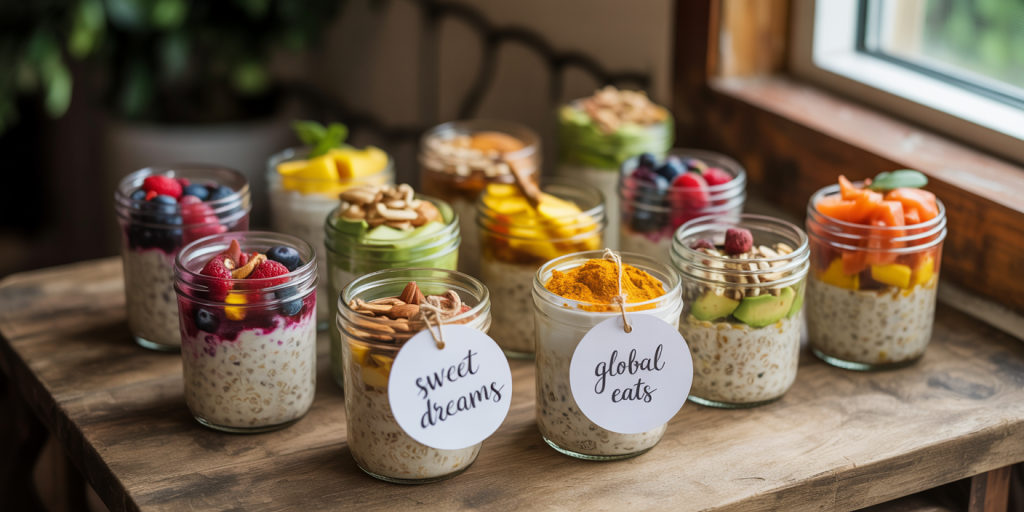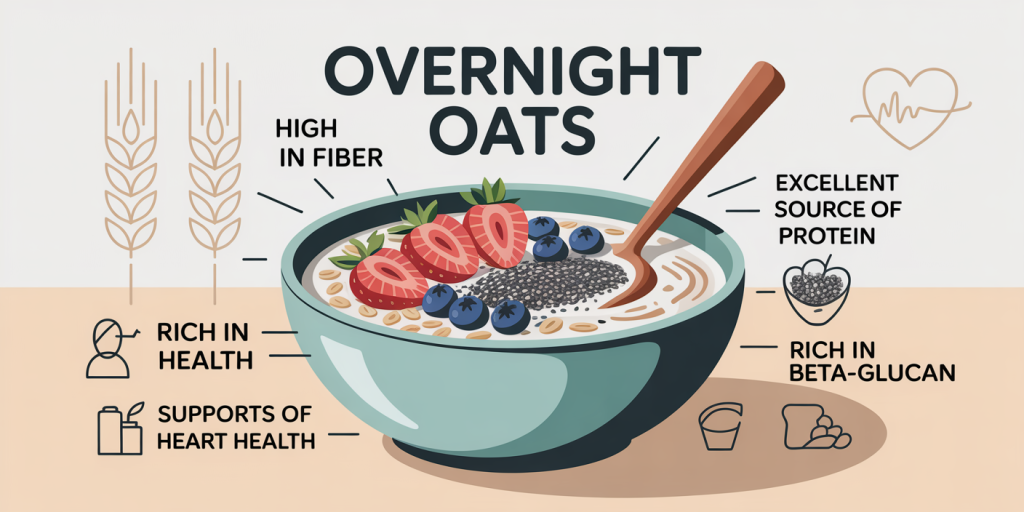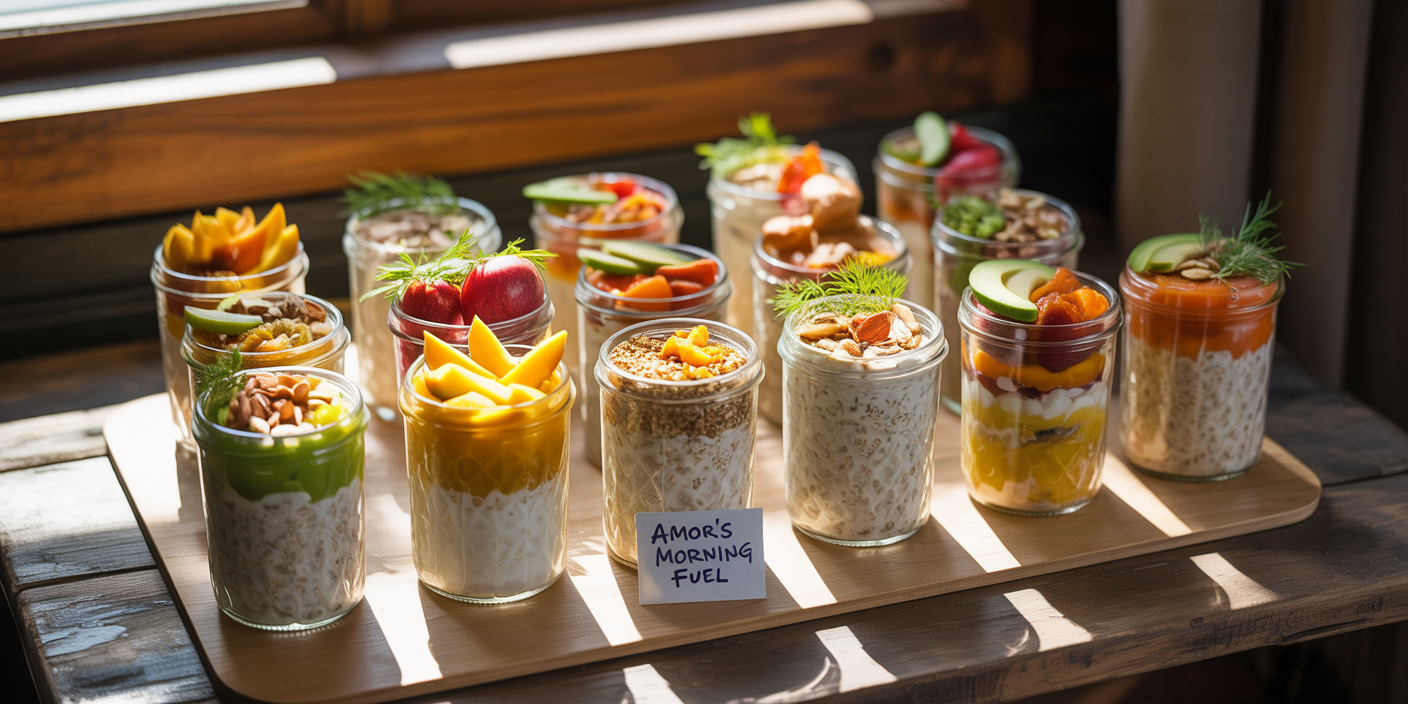The modern breakfast landscape has witnessed a growing interest in healthy, convenient, and versatile meals, and overnight oats have emerged as a front-runner in this domain. These no-cook oats soaked overnight in liquid offer a nutritious and customizable solution that suits various dietary preferences and palates. Beyond convenience, they provide an excellent source of fiber, protein, and essential nutrients, making them ideal for individuals seeking balanced nutrition without sacrificing time in their busy mornings.

According to a 2022 Nielsen report, consumer demand for quick, healthy breakfast options has surged by 25% over the past five years, highlighting the relevance of overnight oats in contemporary diets. This trend is backed by numerous studies showing oats’ cardiovascular benefits, thanks to their beta-glucan content, which can reduce LDL cholesterol by 5-10% when consumed regularly (American Heart Association, 2021). With such strong health credentials combined with limitless personalization possibilities, overnight oats are well-poised to be a staple for every taste.
What Makes Overnight Oats a Nutritional Powerhouse?
Overnight oats combine rolled oats with milk or dairy alternatives and are left to soak overnight, allowing the oats to absorb the liquid and soften without cooking. This process not only enhances texture but preserves the nutritional integrity of the ingredients, unlike high-heat cooking methods which can sometimes degrade sensitive nutrients.
Rolled oats, the foundation of this dish, are packed with complex carbohydrates, fiber, and protein. A typical serving of 40 grams provides approximately 150 calories, 5 grams of protein, and 4 grams of fiber. The soluble fiber beta-glucan is effective in regulating blood sugar and improving digestive health (Harvard T.H. Chan School of Public Health, 2023). Moreover, adding dairy or fortified plant-based milk enhances calcium and vitamin D content, essential for bone health.

Customization with toppings like fruits, nuts, and seeds can elevate micronutrient density. For example, adding a tablespoon of chia seeds provides an extra 5 grams of fiber and omega-3 fatty acids. According to the USDA FoodData Central, apples offer about 19% of the daily recommended vitamin C per medium fruit, making fruit additions a valuable nutrient boost.

Customizing Overnight Oats: Flavors to Match Every Preference
Overnight oats inherently reward creativity. Their neutral base allows infusions of flavor that can cater to savory or sweet preferences, seasonal produce, and dietary restrictions such as veganism or gluten-free living.
For those with a sweet tooth, classic combinations like banana and almond butter or mixed berries with honey and cinnamon remain perennial favorites. In a recent survey conducted by the International Food Information Council (IFIC), 42% of respondents cited fruit-topped overnight oats as their preferred breakfast option, tied to the appeal of natural sweetness and texture variety. For a lower-sugar approach, vanilla extract or unsweetened cocoa powder paired with nuts can provide indulgence without excess calories or additives.
Savory enthusiasts are discovering that overnight oats can double as a non-traditional, nutrient-rich meal. Ingredients like mashed avocado, cherry tomatoes, grated cheddar, or even smoked salmon create a balanced dish high in protein and healthy fats. This adaptation is gaining traction internationally, particularly in Scandinavian countries where breakfast recipes often feature savory oats.
People managing food intolerances or special diets find overnight oats naturally adaptable. Gluten-free rolled oats are widely available, and plant-based milks, such as oat, almond, and soy milk, support lactose-free or vegan lifestyles. Sweeteners can be replaced by natural options like maple syrup or agave nectar. With an abundance of accessible alternatives, overnight oats can meet the demands of diverse dietary needs without compromising flavor or nourishment.
Practical Examples: Popular Overnight Oats Recipes Around the Globe
One compelling aspect of overnight oats is their global adaptability — different cultures incorporate local flavors and ingredients to create distinctive variations.
In the United States, a widely popular recipe involves combining rolled oats with Greek yogurt, chia seeds, and fresh strawberries, topped with a drizzle of honey. It is reported that Greek yogurt adds about 10 grams of protein per serving, aiding muscle repair and satiety.
In India, overnight oats have taken a regional twist by using cardamom, mango pieces, and chopped pistachios. The inclusion of these spices and tropical fruits contributes antioxidants and unique flavors that appeal to traditional palates. Moreover, mangoes contribute vitamin A, essential for immune health.
In Nordic countries, a savory overnight oats recipe might combine oats with grated cheese, boiled eggs, and smoked herring, making for a breakfast rich in omega-3 fatty acids, protein, and calcium. This recipe reflects the regional emphasis on fish intake and hearty breakfasts.
Comparative Table: Nutritional Content of Three Popular Overnight Oats Recipes (per serving)
| Ingredient Combination | Calories | Protein (g) | Fiber (g) | Fat (g) | Sugar (g) |
|---|---|---|---|---|---|
| Greek Yogurt, Strawberries, Chia Seeds | 320 | 18 | 8 | 6 | 10 |
| Mango, Cardamom, Pistachios | 290 | 7 | 6 | 9 | 15 |
| Cheese, Boiled Eggs, Smoked Herring (Savory) | 350 | 25 | 4 | 17 | 2 |
Data derived from USDA FoodData Central and recipe analytics.
Tips for Preparing Perfect Overnight Oats Every Time
Achieving the ideal consistency and flavor balance requires attention to detail in ingredient ratios and preparation steps.
The basic ratio for oats to liquid is 1:1 or 1:1.5, adjusted based on personal texture preferences. Rolled oats absorb liquid better than steel-cut oats, which require longer soaking and may yield a chewier texture. Experimenting with different liquids (cow’s milk, soy milk, almond milk, or even fruit juice) can significantly alter taste and nutrient profiles.
Adding thickening agents such as chia seeds or Greek yogurt can improve texture and protein content. For flavor enhancement, spices like cinnamon, nutmeg, or vanilla extract work well without adding calories.
Refrigeration for at least 6-8 hours (typically overnight) allows full hydration. Preparing multiple servings saves time; overnight oats can be stored in airtight containers for up to 3 days without spoilage.
A practical tip for busy individuals includes assembling a weekly “breakfast jar” with varied toppings pre-measured to mix fresh each morning, maintaining freshness and variety.
Health Benefits Backed by Scientific Evidence
A growing body of research highlights the benefits of oats in promoting heart health, weight management, and digestive wellness. A meta-analysis published in the “Journal of Nutrition” (2022) involving over 10,000 participants demonstrated regular oat consumption was associated with a 12% reduction in risk of coronary heart disease.
Overnight oats, because they are soaked rather than cooked, retain certain heat-sensitive nutrients such as B vitamins better compared to traditional hot oatmeal. The beta-glucan in oats can reduce cholesterol levels, lower postprandial blood glucose spikes, and improve satiety, aiding weight control (Mayo Clinic, 2023).
In addition to fiber and antioxidants, the option to include diverse superfoods like flaxseeds, pumpkin seeds, or berries enhances the meal’s functional properties. Overall, overnight oats provide a substantial nutrient package ideal for sustained energy and metabolic regulation.
Future Perspectives: Innovations and Trends in Overnight Oats
With ongoing consumer interest in functional foods and personalized nutrition, overnight oats are poised for innovation in several domains. The demand for plant-based, allergen-friendly options continues to inspire product developers to craft ready-to-eat or quick-mix overnight oats with unique ingredient blends.
Advances in food technology may soon improve shelf life and texture without preservatives, benefiting manufacturers and consumers alike. Emerging trends also include fortified oats mixes targeting specific health needs, such as added protein blends for athletes or enhanced fiber for gut health.
Technology integration, through apps and smart kitchen devices, might support personalized recipes and portion tracking based on user data. Sustainability also plays a central role, with a shift toward organic oats and environmentally friendly packaging increasingly common.
As awareness about digestive health and nutrient-dense breakfasts grows, overnight oats will likely evolve from a niche option to a mainstream staple, adaptable to new tastes and lifestyles worldwide.
—
Overnight oats’ versatility and substantial health benefits make them an exceptional breakfast choice suitable for any taste or dietary requirement. Their rich, nutrient-packed profile combined with endless customization options ensures they remain relevant, appealing, and beneficial in today’s fast-paced dietary environment. From sweet to savory, traditional to innovative, overnight oats provide a meal that nourishes the body while respecting the demands of modern living.

Deixe um comentário